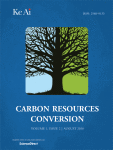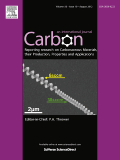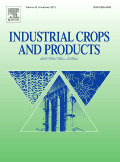
Carbon Resources Conversion
Scope & Guideline
Exploring the Frontiers of Carbon Resource Science
Introduction
Aims and Scopes
- Carbon Conversion Technologies:
The journal emphasizes advanced technologies for converting various carbon sources, including biomass, waste, and fossil fuels, into valuable products such as fuels, chemicals, and materials. - Sustainable Materials Development:
Research on the development of sustainable materials, particularly those derived from carbon resources, is a core focus, including studies on activated carbons, biochar, and nanocomposites. - Environmental Impact and Remediation:
The journal covers studies related to the environmental implications of carbon resource conversion, including waste management, pollution control, and the development of green technologies. - Catalysis and Reaction Engineering:
A significant emphasis is placed on catalysis and reaction engineering methodologies that enhance the efficiency and selectivity of carbon conversion processes. - Bio-based and Renewable Resources:
Research exploring the valorization of bio-based resources and the integration of circular economy principles is a key area, with a focus on converting organic waste into useful products.
Trending and Emerging
- Green Chemistry and Sustainable Practices:
There is a notable increase in research focusing on green chemistry approaches, including the development of environmentally friendly catalysts and processes that minimize waste and energy use. - Carbon Capture and Utilization (CCU):
Recent publications show a growing interest in carbon capture technologies and their utilization in the production of fuels and chemicals, which is critical for addressing climate change. - Biomass and Waste Valorization:
Emerging research themes include the conversion of biomass and various waste materials into valuable products, highlighting the importance of circular economy practices. - Advanced Materials for Energy Applications:
There is a rising trend in the development of advanced carbon-based materials for energy storage and conversion applications, including supercapacitors and battery technologies. - Microbial and Enzymatic Processes:
The journal has seen an increase in studies exploring microbial and enzymatic processes for the conversion of carbon resources, emphasizing biotechnological innovations.
Declining or Waning
- Traditional Fossil Fuel Research:
Research specifically focused on traditional fossil fuel conversion processes has been decreasing, likely due to a greater emphasis on renewable and sustainable alternatives. - Conventional Waste Management Techniques:
Papers centered on conventional waste management strategies are appearing less frequently as the journal pivots towards innovative, sustainable waste valorization methods instead. - Non-renewable Carbon Feedstocks:
The exploration of non-renewable carbon feedstocks for conversion processes is waning, reflecting an industry-wide shift towards renewable and sustainable carbon sources. - Basic Theoretical Studies:
The journal has seen a decline in the publication of purely theoretical studies without practical applications, as there is a growing demand for research that has direct implications for technology and sustainability.
Similar Journals

Carbon Capture Science & Technology
Catalyzing Change: Bridging Science and Sustainability in Carbon CaptureCarbon Capture Science & Technology, published by Elsevier, is an esteemed, peer-reviewed, open access journal dedicated to advancing research in the growing fields of chemical engineering, energy, and environmental science. With an ISSN of 2772-6568, this influential journal has established itself since its inception in 2021 and continues to make notable contributions, reflected in its impressive Q1 rankings across multiple categories, including a #14 rank in Environmental Science and a #13 rank in Chemical Engineering as of 2023. The journal aims to provide a platform for the dissemination of innovative carbon capture technologies and methodologies that address vital climate challenges, ensuring broad accessibility for researchers, professionals, and students alike. By embracing open access, Carbon Capture Science & Technology fosters a collaborative approach to knowledge sharing, making it an indispensable resource for those committed to sustainability and environmental preservation.

CARBON
Pioneering Discoveries in Carbon-Based MaterialsCARBON is a leading peer-reviewed journal published by PERGAMON-ELSEVIER SCIENCE LTD, focusing on the realms of Chemistry and Materials Science. With an impressive impact factor, CARBON is ranked within the top quartile (Q1) of both fields in the 2023 Scimago Journal Rank, remarkably securing the 18th position out of 463 in General Materials Science and the 22nd position out of 408 in General Chemistry. Since its inception in 1963, the journal has been dedicated to publishing high-quality research that advances the understanding of carbon-based materials and their applications. Operating from the United Kingdom, CARBON provides an essential platform for researchers, professionals, and students alike to disseminate their findings and innovations. Although not an open-access journal, it offers access options that maintain the integrity and high standards of academic publishing. As a critical resource in its field, CARBON continues to foster scientific dialogue and development, significantly impacting current and future research.

BioResources
Unleashing the potential of renewable resources for global impact.BioResources is a pioneering open access journal launched in 2006, dedicated to disseminating knowledge at the intersection of bioengineering, environmental engineering, and waste management. Published by NORTH CAROLINA STATE UNIVERSITY DEPARTMENT OF WOOD & PAPER SCIENCE, this journal serves as a vital platform for researchers and professionals to explore the sustainable use of biomaterials and renewable resources. With an impact reflected through its Scopus rankings, including a respectable position in the 2023 quartile rankings across several relevant categories, BioResources is committed to advancing scientific discourse and enhancing the understanding of bioresource utilization. The journal not only supports high-quality research but also encourages contributions that shape environmental policies and practices. Accessible globally, it invites active participation from scholars aiming to contribute to a more sustainable future. Researchers, professionals, and students alike will find valuable insights and groundbreaking research within its pages as it continues to foster knowledge and innovation in the field.

Carbon Letters
Innovating Sustainable Solutions Through Research.Carbon Letters, published by SPRINGER JAPAN KK, is a premier academic journal based in Singapore that focuses on groundbreaking research in the fields of Ceramics and Composites, Energy Engineering, Inorganic Chemistry, Materials Chemistry, and Organic Chemistry. With an exceptional reputation reflected in its 2023 category quartiles, which include Q1 rankings across multiple disciplines, this journal serves as a vital resource for researchers and professionals seeking to stay at the forefront of carbon-related studies and applications. Although it is not an open access publication, Carbon Letters facilitates the dissemination of high-quality research addressing contemporary challenges in renewable energy, sustainability, and environmental engineering, supporting the academic community's efforts in advancing science and technology. The journal has a robust converged period from 2014 to 2024, signaling its ongoing commitment to excellence in academia.

FUEL PROCESSING TECHNOLOGY
Exploring the forefront of energy and environmental sustainability.FUEL PROCESSING TECHNOLOGY, published by Elsevier, is a highly regarded scholarly journal dedicated to advancing the field of fuel processing and technology. With an impressive Q1 ranking in major categories such as Chemical Engineering, Energy Engineering, and Fuel Technology, this journal serves as a vital resource for researchers, professionals, and students alike, offering cutting-edge research and comprehensive reviews since its inception in 1977. Boasting a Scopus ranking that places it within the top 10% of its field, FUEL PROCESSING TECHNOLOGY is committed to disseminating innovative findings and methodologies that are crucial for the development of sustainable fuel technologies. In line with its commitment to accessibility, the journal will transition to Open Access status starting in 2024, thereby broadening the reach and impact of valuable research. Located in Amsterdam, Netherlands, the journal is strategically positioned to foster global collaboration and dialogue, making it an essential platform for scholars dedicated to the critical challenges in energy and environmental sustainability.

Carbon Trends
Connecting Discoveries in Chemistry and Materials ScienceCarbon Trends is a cutting-edge, openly accessible journal published by ELSEVIER, dedicated to advancing research and discussion in the domains of Chemistry, Materials Chemistry, and Materials Science. Established in 2020, this journal has quickly become a pivotal platform for scientists and researchers to share innovative findings related to carbon materials and their applications. With a solid impact factor and a ranking in the second quartile (Q2) across multiple subject categories, including a percentile standing in the top two-thirds of global publications, Carbon Trends plays an essential role in shaping the future of materials science. The journal’s open access model ensures that valuable research is accessible to a broad audience, facilitating collaboration and knowledge dissemination. Researchers, professionals, and students alike will benefit from the insights and trends published within its pages, guiding them in the rapidly evolving field of carbon sciences.

INDUSTRIAL CROPS AND PRODUCTS
Elevating Knowledge in Crop Diversification and ApplicationsINDUSTRIAL CROPS AND PRODUCTS is a premier journal dedicated to the field of agronomy and crop science, published by Elsevier. With an impressive impact factor that places it in the Q1 quartile for its subject category, this journal ranks among the top 29 out of 406 in Agricultural and Biological Sciences, demonstrating its significance and influence within the academic community. Since its inception in 1992, it has been committed to disseminating high-quality research that advances the understanding of industrial crops and their applications. The journal is an excellent resource for researchers, professionals, and students who are keen to explore novel findings, methodologies, and approaches in crop diversification and product development. Although it does not currently offer open access options, it maintains a rigorous peer-review process to ensure that only the most impactful research is published. As it continues to grow and evolve through to 2024, INDUSTRIAL CROPS AND PRODUCTS remains a crucial platform for those looking to make significant contributions to the field.

Carbon Energy
Advancing sustainable solutions for a greener tomorrow.Welcome to Carbon Energy, an esteemed open-access journal published by WILEY that focuses on cutting-edge research in the field of energy and materials science. Since its inception in 2019, this journal has quickly established itself as a leading platform for disseminating impactful findings and innovations related to carbon-based energy solutions, renewable resources, and sustainability practices. With its impressive Q1 rankings in multiple categories—including Energy (miscellaneous), Materials Chemistry, and Renewable Energy—Carbon Energy is recognized for delivering high-quality, peer-reviewed content that meets the rigorous standards of the academic community. Through its open-access model, the journal ensures wide accessibility of research findings, making it an invaluable resource for researchers, professionals, and students alike. As we look toward the future, Carbon Energy aims to further its mission of advancing sustainable energy technologies and promoting interdisciplinary collaboration in tackling global energy challenges.

Boletin del grupo espanol del carbon
Exploring Innovations in Carbon Materials and TechnologyBoletin del Grupo Español del Carbon, a pivotal journal in the field of carbon science, is published by the Grupo Español Carbon and serves as a significant platform for disseminating research related to carbon materials, their applications, and advancements in carbon technology. With an ISSN of 2172-6094, this journal aims to bridge the gap between academia and industry by featuring original research articles, reviews, and noteworthy contributions from specialists in the sector. Though currently not designated as Open Access, the journal's commitment to quality ensures that the articles are available through various academic databases, enhancing accessibility for researchers, professionals, and students alike. Located in Zaragoza, Spain, at the prestigious Instituto Carboquímica, the journal endorses rigorous peer review and strives to foster international collaboration within the carbon research community. By maintaining high academic standards, Boletin del Grupo Español del Carbon aspires to impact the fields of materials science and environmental sustainability significantly.

Chemistry for Sustainable Development
Exploring Chemical Innovations to Preserve Our PlanetChemistry for Sustainable Development is a leading journal dedicated to the exploration of innovative chemical studies that promote sustainability and environmental preservation. Published by the esteemed PUBLISHING HOUSE RUSSIAN ACAD SCIENCES, SIBERIAN BRANCH, this journal serves as a crucial platform for researchers, professionals, and students engaged in the field of chemistry, particularly those focused on sustainable practices and green technologies. With an ISSN of 0869-8538, the journal aims to bridge the gap between theoretical research and practical applications that align with sustainable development goals. By fostering interdisciplinary collaboration and sharing cutting-edge findings, Chemistry for Sustainable Development plays a vital role in addressing pressing global challenges such as climate change, resource depletion, and environmental degradation. Though currently not open access, the journal is committed to disseminating knowledge that inspires innovative solutions for a sustainable future.